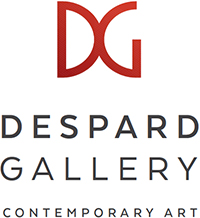The works in Steven Carson’s Casting and Weeding series continue to explore the use of non-traditional materials and simple fabrication techniques to make colourful geometric abstract paintings. Within the conceptual framework of hybrid and interdisciplinary practice the work questions dominant art forms through the use of unconventional materials, the fabrication processes and a rejection of traditional technical expertise as a fundamental indicator of artistic integrity.
The source material for the works in this series is a PVC film commonly used in the sign-writing industry. In its manufacture liquid vinyl is cast into thin sheets of workable plastic. Weeding is the sign writer’s process of peeling away unwanted areas of computer-cut vinyl prior to its application. The aluminium used as the support for the works suggests a connection to manufacturing plants and hardware suppliers. Carson’s vinyl works on aluminium are unconstrained by traditional frames or other conventions of painterly production and presentation, suggesting each is a kind of sign for a painting rather than an authentic painting in the traditional sense.
The cast PVC film – the palette for these paintings – was initially sourced as off-cuts from digitally produced signs, many of which have been created for retail and fast food industries. Specific colours suggest the corporate identities of a range of businesses: for example the pink colour used is reminiscent of the signage from a popular ice-cream franchise, and other colours suggest a range of consumer products from unleaded petrol to confectionary. In Carson’s Casting and Weeding works the tacky plasticity of the adhesive vinyl refers to the synthetic quality of acrylic paint, itself a new commercial material utilised in Bridget Riley’s mid 20th century Op Art paintings and works by numerous Pop artists. The choice of cast vinyl in Carson’s works can be seen as a critical alternative to both oil and acrylic paint as the medium for his paintings.
At close range the method of construction and materials and evidence of the handmade becomes apparent. The handmade gesture is evident in the exaggeratedly wonky scissor cuts and marks left by the hand-trimming of the sign writing film on its aluminium support. These traces reveal the hand of the maker within the artwork and also highlight and shift the cast vinyl material from its original industrial context. The vinyl used in the works has not been digitally cut, nor planned using the digital software common to both visual arts and sign writing trades. Instead, intuitive combinations of colours have been overlayed and then cut by hand, making subtle allusions to craft processes as well as to spontaneous decision-making as a signifier of artistic creativity.
The titles of Carson’s works emphasise the hybrid nature of his inquiry, for example Hand Cut plays with the slogans of advertising, suggesting a measure of quality and care, specifically in the production of consumer commodities. Safety and Danger evokes manufacturing industries through the use of reflective safety barrier tape, reconfigured to produce geometric paintings.
The works in the Casting and Weeding exhibition prompt a wide range of responses, yet it is Steven Carson’s intention that the works neither fit entirely within their artistic nor their industrial contexts.
-Olga Sankey, 2010
Olga Sankey is currently Program Director BVA Honours, School of Architecture and Design, University of South Australia.























